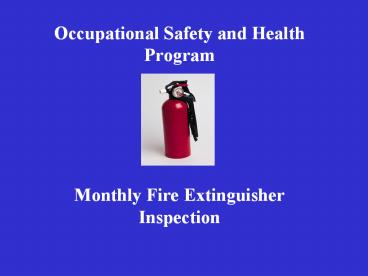Occupational Safety and Health Program Monthly Fire Extinguisher Inspection - PowerPoint PPT Presentation
1 / 14
Title:
Occupational Safety and Health Program Monthly Fire Extinguisher Inspection
Description:
Occupational Safety and Health Program Monthly Fire Extinguisher Inspection Getting Credit and Certificate To get full credit and certificate for this class, the ... – PowerPoint PPT presentation
Number of Views:366
Avg rating:3.0/5.0
Title: Occupational Safety and Health Program Monthly Fire Extinguisher Inspection
1
Occupational Safety and Health
ProgramMonthly Fire Extinguisher
Inspection
2
Getting Credit and Certificate
- To get full credit and certificate for this
class, the class facilitator should do the
following - Present the Power Point Presentation and have
all students study any handouts. - Enter the appropriate information into the
facilitys training records. - Send the following information by e-mail to the
Cabinets Safety Coordinator for each student in
the class - -name,
- -work address,
- -work title,
- -name of class,
- -date of class.
- Safety Coordinator-Richard T. Owen at
Richard.Owen_at_ky.gov. - The certificates will be returned to the class
facilitator for distribution
3
Governing Standards
- OSHA 29 CFR 1910.157 (c)(2)-Monthly
4
Monthly Inspections
- Each extinguisher in its designated place.
- Clearly visible and not blocked by equipment,
coats or other objects that could interfere with
emergency access. - Nameplate with operating instructions legible and
facing outward.
5
Monthly Inspections
- Pressure gauge showing that the extinguisher is
full charged. The needle should be in the green
zone. - Pin and tamper seal intact.
- Extinguisher in good condition and showing no
signs of physical damage, corrosion or leakage.
6
Monthly Inspections
- Dry powder extinguishers are gently rocked top
to bottom, or gently struck on the bottom with a
rubber mallet (or both) to make sure the powder
is not packing.
7
Monthly Inspections-Documentation
- Fire Extinguisher Card Around Neck of Unit
- Date of inspection.
- Initials of the person performing the
inspection. - Passed or failed inspection.
8
Visual Examination of the Fire Extinguishers
Exterior
- Pits and dents in the cylinder shell indicate
damage and could be a hazard to the operator. - Dents of 1/4 inch are justification to replace a
fire extinguisher.
9
Pressure Gage of Each Fire Extinguisher
- Insure that each unit is fully pressurized, scale
is to be in the green area of the gage.
10
Discharge Hose of Fire Extinguisher
- Inspect hose for blockage.
- Clean out the hose.
- Inspect discharge hose for cracks and cuts. If
cracks and/or cuts are found, replace the hose.
11
Inspect Mounting Assembly on Cylinder
- Inspect for bent, broken or damaged assembly.
- Damaged or broken mounting assemblies can not be
welded or soldered. If such damage is found, the
fire extinguisher must be condemned per NFPA
Standard 10.
12
Inspect Each of the Following Extinguisher Parts
- Verify that locking pin-Pin must be easily
removed and is not bent. - Verify safety seal-Seal must be breakable, not a
type that has to be cut. - Verify and handle/level-Must have smooth
operation.
13
Verify Location and Hazard
- Mounting-Ensure unit is installed securely on
correct mounting hook or bracket. - Verify-Hazard application to be sure unit is
right for the potential fire hazard.
14
Thanks for Attending
- For additional assistance contact
- Richard T. Owen
- Education Cabinet Safety Coordinator
- 601 East Main Street
- Frankfort, Kentucky
- 502-564-7346
- Richard.Owen_at_ky.gov





























